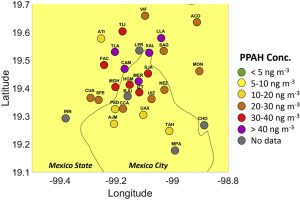当前位置:
X-MOL 学术
›
Atmos. Environ.
›
论文详情
Our official English website, www.x-mol.net, welcomes your feedback! (Note: you will need to create a separate account there.)
On particle-bound polycyclic aromatic hydrocarbons (PPAH) and links to gaseous emissions in Mexico city
Atmospheric Environment ( IF 5 ) Pub Date : 2018-12-01 , DOI: 10.1016/j.atmosenv.2018.09.022 Luis A. Ladino , Graciela B. Raga , Darrel Baumgardner
Atmospheric Environment ( IF 5 ) Pub Date : 2018-12-01 , DOI: 10.1016/j.atmosenv.2018.09.022 Luis A. Ladino , Graciela B. Raga , Darrel Baumgardner

|
Abstract Mexico City is a densely populated megacity with average PM10 and PM2.5 levels frequently above those indicated as health-threatening for humans by the World Health Organization. Polycyclic aromatic hydrocarbons (PAH) can be emitted by anthropogenic sources as the result of the incomplete combustion of organic matter and fossil fuels and they represent an important risk for human health under poor air quality conditions. High concentrations of PAHs have been linked with cancer and other respiratory diseases. Particle-bound PAHs (PPAHs) have been previously studied in Mexico City; however, their temporal scales are not fully understood given the short sampling periods (no more than five weeks) during which time they were evaluated. Recent automated and continuous measurements of PPAH concentration made in Mexico City during one full year (April 2016 to March 2017) show an average PPAH concentration of 31.7 ± 29.9 ng m−3 at the sampling location. The highest concentrations were observed in the winter corresponding to the cold dry season. On a daily basis, the maximum concentrations were observed between 06:00 and 11:00 am, as high as 495 ng m−3. The average PPAHs levels measured in the spring of 2016 were found to be ca. 150% higher than those that were measured 13 years previously in the spring of 2003, in approximately the same location and with the same equipment. A conceptual model is introduced to explain the primary processes behind the daily evolution of PPAHs that are produced from primary emissions but whose concentrations decrease due to evaporation and dilution with rising temperatures. Given the lack of instrumentation to measure PPAH at most air quality monitoring stations, a proxy is developed based upon correlations with the concentrations of carbon monoxide (CO) and nitrous oxides (NOx), which are typically measured at urban monitoring stations worldwide and that are co-emitted with PAHs. An example application of parametrizations with this proxy suggest that people living in the North and Northwest of Mexico City are at greater health risk given that in these locations the PPAH concentrations are expected to be higher than in the rest of the city.
中文翻译:

关于粒子结合多环芳烃 (PPAH) 和墨西哥城气体排放的联系
摘要 墨西哥城是一个人口稠密的特大城市,平均 PM10 和 PM2.5 水平经常高于世界卫生组织指出的对人类健康构成威胁的水平。由于有机物质和化石燃料的不完全燃烧,人为来源会排放多环芳烃 (PAH),在空气质量差的情况下,它们对人类健康构成重要威胁。高浓度的多环芳烃与癌症和其他呼吸系统疾病有关。之前在墨西哥城曾研究过颗粒结合多环芳烃 (PPAH);然而,鉴于对它们进行评估的时间很短(不超过五周),它们的时间尺度还没有被完全理解。最近一整年(2016 年 4 月至 2017 年 3 月)在墨西哥城进行的 PPAH 浓度自动连续测量显示,采样位置的平均 PPAH 浓度为 31.7 ± 29.9 ng m-3。在与寒冷干燥季节相对应的冬季观察到最高浓度。每天上午 06:00 至 11:00 之间观察到最大浓度,高达 495 ng m-3。发现 2016 年春季测量的平均 PPAH 水平约为 比 13 年前 2003 年春季在大致相同的地点和相同的设备测量的结果高 150%。引入了一个概念模型来解释 PPAH 日常演变背后的主要过程,这些 PPAH 由主要排放物产生,但其浓度会因蒸发和温度升高稀释而降低。鉴于大多数空气质量监测站缺乏测量 PPAH 的仪器,根据与一氧化碳 (CO) 和一氧化二氮 (NOx) 浓度的相关性开发了一种代理,这些浓度通常在全球城市监测站进行测量,并且与多环芳烃共同排放。使用此代理进行参数化的一个示例应用表明,居住在墨西哥城北部和西北部的人们面临更大的健康风险,因为这些地区的 PPAH 浓度预计高于该市其他地区。鉴于大多数空气质量监测站缺乏测量 PPAH 的仪器,根据与一氧化碳 (CO) 和一氧化二氮 (NOx) 浓度的相关性开发了一种代理,这些浓度通常在全球城市监测站进行测量,并且与多环芳烃共同排放。使用此代理进行参数化的一个示例应用表明,居住在墨西哥城北部和西北部的人们面临更大的健康风险,因为这些地区的 PPAH 浓度预计高于该市其他地区。鉴于大多数空气质量监测站缺乏测量 PPAH 的仪器,根据与一氧化碳 (CO) 和一氧化二氮 (NOx) 浓度的相关性开发了一种代理,这些浓度通常在全球城市监测站进行测量,并且与多环芳烃共同排放。使用此代理进行参数化的一个示例应用表明,居住在墨西哥城北部和西北部的人们面临更大的健康风险,因为这些地区的 PPAH 浓度预计高于该市其他地区。通常在世界各地的城市监测站进行测量,并与 PAH 共同排放。使用此代理进行参数化的一个示例应用表明,居住在墨西哥城北部和西北部的人们面临更大的健康风险,因为这些地区的 PPAH 浓度预计高于该市其他地区。通常在世界各地的城市监测站进行测量,并与 PAH 共同排放。使用此代理进行参数化的一个示例应用表明,居住在墨西哥城北部和西北部的人们面临更大的健康风险,因为这些地区的 PPAH 浓度预计高于该市其他地区。
更新日期:2018-12-01
中文翻译:

关于粒子结合多环芳烃 (PPAH) 和墨西哥城气体排放的联系
摘要 墨西哥城是一个人口稠密的特大城市,平均 PM10 和 PM2.5 水平经常高于世界卫生组织指出的对人类健康构成威胁的水平。由于有机物质和化石燃料的不完全燃烧,人为来源会排放多环芳烃 (PAH),在空气质量差的情况下,它们对人类健康构成重要威胁。高浓度的多环芳烃与癌症和其他呼吸系统疾病有关。之前在墨西哥城曾研究过颗粒结合多环芳烃 (PPAH);然而,鉴于对它们进行评估的时间很短(不超过五周),它们的时间尺度还没有被完全理解。最近一整年(2016 年 4 月至 2017 年 3 月)在墨西哥城进行的 PPAH 浓度自动连续测量显示,采样位置的平均 PPAH 浓度为 31.7 ± 29.9 ng m-3。在与寒冷干燥季节相对应的冬季观察到最高浓度。每天上午 06:00 至 11:00 之间观察到最大浓度,高达 495 ng m-3。发现 2016 年春季测量的平均 PPAH 水平约为 比 13 年前 2003 年春季在大致相同的地点和相同的设备测量的结果高 150%。引入了一个概念模型来解释 PPAH 日常演变背后的主要过程,这些 PPAH 由主要排放物产生,但其浓度会因蒸发和温度升高稀释而降低。鉴于大多数空气质量监测站缺乏测量 PPAH 的仪器,根据与一氧化碳 (CO) 和一氧化二氮 (NOx) 浓度的相关性开发了一种代理,这些浓度通常在全球城市监测站进行测量,并且与多环芳烃共同排放。使用此代理进行参数化的一个示例应用表明,居住在墨西哥城北部和西北部的人们面临更大的健康风险,因为这些地区的 PPAH 浓度预计高于该市其他地区。鉴于大多数空气质量监测站缺乏测量 PPAH 的仪器,根据与一氧化碳 (CO) 和一氧化二氮 (NOx) 浓度的相关性开发了一种代理,这些浓度通常在全球城市监测站进行测量,并且与多环芳烃共同排放。使用此代理进行参数化的一个示例应用表明,居住在墨西哥城北部和西北部的人们面临更大的健康风险,因为这些地区的 PPAH 浓度预计高于该市其他地区。鉴于大多数空气质量监测站缺乏测量 PPAH 的仪器,根据与一氧化碳 (CO) 和一氧化二氮 (NOx) 浓度的相关性开发了一种代理,这些浓度通常在全球城市监测站进行测量,并且与多环芳烃共同排放。使用此代理进行参数化的一个示例应用表明,居住在墨西哥城北部和西北部的人们面临更大的健康风险,因为这些地区的 PPAH 浓度预计高于该市其他地区。通常在世界各地的城市监测站进行测量,并与 PAH 共同排放。使用此代理进行参数化的一个示例应用表明,居住在墨西哥城北部和西北部的人们面临更大的健康风险,因为这些地区的 PPAH 浓度预计高于该市其他地区。通常在世界各地的城市监测站进行测量,并与 PAH 共同排放。使用此代理进行参数化的一个示例应用表明,居住在墨西哥城北部和西北部的人们面临更大的健康风险,因为这些地区的 PPAH 浓度预计高于该市其他地区。



























 京公网安备 11010802027423号
京公网安备 11010802027423号